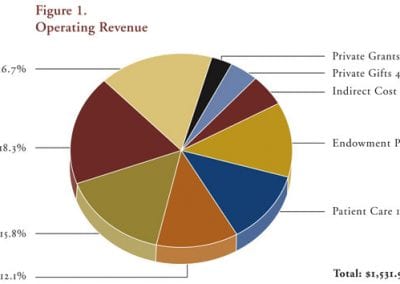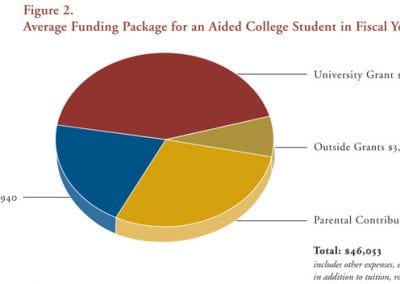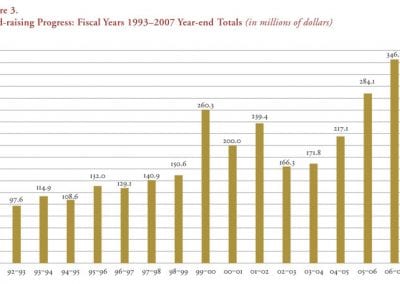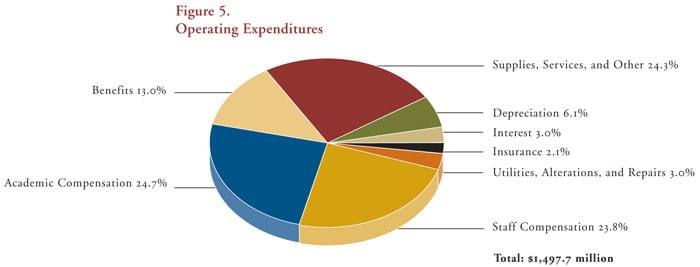Overview of University Results
During fiscal year 2007, revenues grew 11.1 percent to $1,531.9 million, while expenditures increased 6.8 percent to $1,497.7 million. This resulted in a surplus of $34.2 million or 2.2 percent of revenue.
Revenue
The principle source of revenue in fiscal year 2007 was student tuition and fees, followed by government and private funding, the Trustee-approved distribution from the endowment, and patient care revenue (see figure 1).
During fiscal year 2007, there were 13,915 full-time-equivalent students enrolled at the University, including 4,780 in the College. Gross tuition and fees totaled $479.6 million and was the largest single source of revenue. When financial aid for undergraduate and graduate students—a total of $199.8 million—is considered, net tuition totaled $279.8 million, an increase of $20.5 million or 8.0 percent over fiscal year 2006. Overall, including aid to graduate and professional students, the discount totaled 41.7 percent.
Providing financial assistance to undergraduate and graduate students is critical to the successful recruitment and retention of the nation’s brightest talent. Spending for financial aid included $1.1 million for precollegiate aid, $142.9 million for graduate fellowships, and $55.8 million for College students. In keeping with the commitment to admit students to the College without regard to their ability to pay, spending for undergraduate financial aid rose 9.6 percent over the previous year and provided support to 48.1 percent of the undergraduate student body. Sixty-two more students received aid in fiscal year 2007 than in fiscal year 2006, an increase of 2.9 percent. For the average student with aid in the College, the University scholarship was $19,934, an increase of more than 6 percent over the prior year, while total student costs (including tuition, room, board, fees, books, and other academic expenses) averaged $46,053, an increase of 5.9 percent (see figure 2).
For fiscal year 2007, the University’s Trustees authorized a distribution from endowment that was equal to 5.2 percent of the average market value of the endowment during the fiscal years 2003, 2004, and 2005. The 5.2 percent distribution did not include a special payout of $5.4 million to provide continuing support for the Chicago Initiative. The approved distribution provided a total of $193.7 million for operations, an increase of 9.7 percent from the previous year. The endowment’s contribution to the operations was 12.6 percent, which approximated fiscal year 2006 level of 12.8 percent.
Revenue from federal, state, and private sources totaled $446.3 million, an increase of 5.4 percent over the previous year. This included funding from government agencies, private corporations, individuals, and foundations to support the direct and indirect costs associated with a variety of programs, including research projects, instructional programs, financial aid, building projects, and student services. In fiscal year 2007, sponsored program funding accounted for 24.9 percent of total revenue. Federal support, principally for research, totaled $327.4 million, including $256.3 million in direct support and an additional $71.1 million in reimbursements for facilities and administrative costs. The Division of the Biological Sciences (BSD) accounted for $138.4 million or 54 percent of the direct support, a slight increase from fiscal year 2006.
In fiscal year 2007, patient care revenue from the clinical practices within the BSD generated $185.5 million, an increase of $9.9 million or 5.6 percent over fiscal year 2006. The increased revenue was driven by higher intensity activity and volume growth in the subspecialty clinics.
The Chicago Initiative, the largest fund-raising effort in the history of the University, had its most successful year to date. During fiscal year 2007, funds raised from all sources totaled $346.2 million (see figure 3). The total raised during fiscal year 2007 included $25.3 million in unrestricted support through the Annual Funds. Fiscal year 2007 was also a record year for cash, with $333.5 million received (see figure 4).
Expenditures
During fiscal year 2007, spending totaled $1,497.7 million, an increase of 6.8 percent over fiscal year 2006 levels (see figure 5). Staff compensation, faculty compensation, and supplies, services, and other composed the top three spending categories. These items totaled $1,090.1 million and represented 72.8 percent of total fiscal year 2007 spending, a percentage consistent with that for the same categories in fiscal year 2006.
In fiscal year 2007, staff compensation totaled $356.2 million or 23.8 percent of total spending, an increase of $22.6 million or 6.8 percent over the prior year. Academic compensation totaled $370.6 million or 24.7 percent of total spending, an increase of $25.8 million or 7.5 percent. The increases were the result of salary increases for faculty and staff, which in fiscal year 2007 averaged 4.8 percent and 3.3 percent, respectively, and the added costs of new positions.
Spending for employee benefits during fiscal year 2007 totaled $194.4 million, an increase of 1.3 percent or $2.5 million over fiscal year 2006 levels. The University made an end-of-year contribution of $1.5 million to the defined-benefit pension plan.
The cost of the University’s comprehensive insurance program for fiscal year 2007 was $31.8 million. Of this amount, about 88.4 percent or approximately $28.1 million was for medical malpractice coverage for the clinical faculty. The University and the Medical Center share the cost of medical malpractice insurance at 55 percent and 45 percent, respectively.




